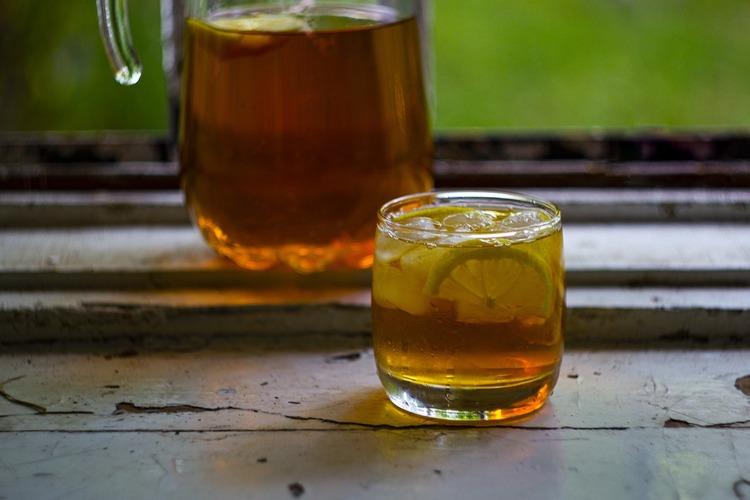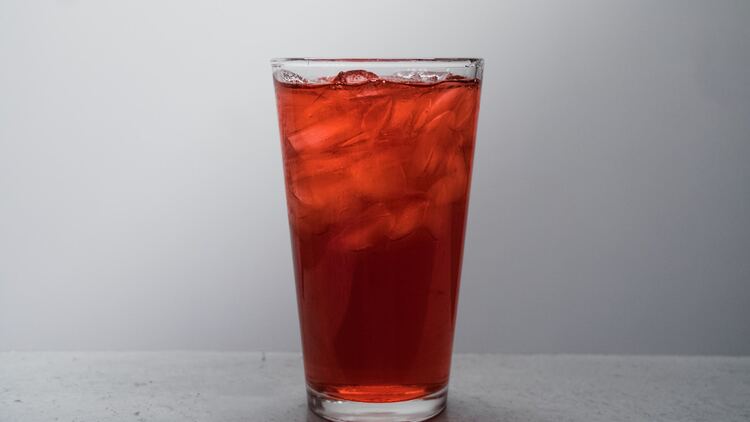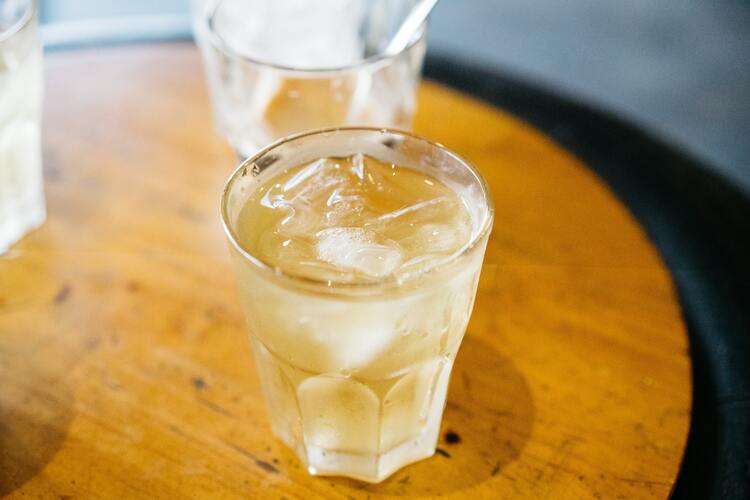Are you looking for a refreshing twist on the classic tea experience? Look no further. With its many types and varieties, Japanese iced tea is waiting to be discovered.
To start your exploration of Japanese iced tea, it’s essential to understand the different types of tea that can be used, from sencha to hojicha. Each tea variety has a specific flavor profile and benefits, letting you customize your iced tea experience to suit your taste preferences and lifestyle.
So, grab your favorite tea set, some high-quality Japanese tea leaves, and ice because it’s time to embark on a fun journey. In this article, you will learn about the history, brewing methods, and various Japanese iced tea serving styles.
Please note: This article contains affiliate links, meaning I may earn a commission if you make a purchase by clicking a link. Of course, this comes at no extra cost to you and helps me keep offering readers solid information.

Japanese Iced Tea Types
Green Tea Varieties
Green tea is one of the most popular and revered beverages in Japan. It has a long and fascinating history dating back to ancient times, and it continues to be an integral part of Japanese culture and daily life.
Therefore, green tea will be the main base or option when preparing iced tea. There are several types to enjoy, with distinct flavors and characteristics:
- Sencha: The most common type of green tea (accounts for about 80% of all tea produced in Japan), often served at meals, has a fresh grassy taste. Sencha is made from the uppermost leaves of the tea plant, carefully picked and steamed to prevent oxidation.
- Gyokuro: A more premium, shade-grown tea offering a sweet, umami flavor.
- Tencha: The base for creating matcha, known for its bright green color.
- Kukicha: A blend of tea leaves and stems, offering a light and refreshing taste.
- Uji: A high-quality tea from the region around Kyoto.
The options above will result in a light beverage. If you are looking for something more robust, you can opt for the following green teas:
- Bancha: The tea leaves used to produce bancha are usually harvested later in the season after the first flush of high-quality sencha leaves has been picked. The flavor of bancha is characterized by its earthy and somewhat rustic notes. The aging process of the leaves imparts a subtle sweetness and a mild astringency to the tea.
- Tencha Karigane: A blend of tencha stems and leaves, offering a rich, malty taste.
And let’s not forget about matcha, a finely ground green tea powder that has gained popularity worldwide as an ingredient in various beverages and desserts.
Black Tea
While Japan is more renowned for its green tea varieties, black tea, or Wakoucha, has been gaining popularity recently, offering a twist on the traditional tea experience.
Unlike the well-established black tea production in countries like India and Sri Lanka, Japanese black tea is a relatively newer addition to the global tea market. The production of wakoucha began in the late 19th century when Japanese tea growers started experimenting with different tea processing methods.
The flavor of Japanese black tea can vary depending on the specific region and production methods. However, it generally offers a smooth, malty taste with subtle floral and fruit undertones. Some wakoucha teas may exhibit a touch of astringency or bitterness, adding complexity to the drinking experience.
You should not encounter difficulties buying this tea in specialty shops or online.
Roasted Tea
Roasted Japanese teas have a unique flavor profile, with toasty, earthy notes that lend themselves incredibly well to iced tea. Some options to explore include:
- Hojicha: A roasted green tea with a rich aroma and a mellow, caramel-like taste.
- Genmaicha: A blend of green tea and toasted rice, offering a savory, comforting flavor.
- Mugicha: A caffeine-free option made from roasted barley, perfect for a hydrating iced brew.

Brewing Japanese Iced Tea
Cold Brew Method (Mizudashi)
The Japanese cold brew method for preparing tea is known as “mizudashi,” meaning “water steeping.” This method involves steeping tea leaves in cold water over an extended period, typically several hours or overnight, to extract the flavors slowly without using hot water.
It is a simple and refreshing way to prepare various tea types, mainly green or herbal teas, creating a smooth and mellow flavor profile.
Here’s a step-by-step guide on how to make Japanese cold-brew tea:
- Select the tea: Choose high-quality tea leaves suitable for cold brewing. We discussed options in the previous section.
- Measure the tea leaves: Depending on your preference and the tea’s strength, measure around 1 to 1.5 tablespoons of tea leaves per 8 ounces (240 ml) of cold water. Adjust the amount to suit your taste.
- Add cold water: Place the measured tea leaves in a teapot, pitcher, or any container suitable for steeping tea (we recommend using a pitcher with a built-in infuser). Add cold, filtered water to the container. The ratio of tea leaves to water can be adjusted to achieve your desired strength.
- Gently stir: Use a spoon or chopsticks to gently stir the tea leaves and water, ensuring that the leaves are fully immersed.
- Steeping time: Cold brewing requires longer to extract the flavors. For most Japanese green teas, steep for at least 2 to 4 hours at room temperature or in the refrigerator. Some herbal teas may require longer steeping times.
- Strain the tea: After steeping, strain the tea to separate the leaves from the liquid. You can use a fine-mesh strainer or a tea filter. If you used a teapot with a built-in infuser, remove the infuser with the tea leaves.
- Serve and enjoy: Once the tea is strained, it will be served. Japanese cold brew tea is often served over ice, but you can adjust the dilution by adding more water if desired.
Ice Brew Method (Kōridashi)
The Kōridashi brewing method is a traditional Japanese technique used to prepare high-quality green tea, particularly gyokuro and some high-grade sencha teas.
This method involves placing tea leaves in a teapot (or appropriate vessel) and covering them with ice cubes. As the ice slowly melts, flavor is extracted from the leaves. Connoisseurs affirm this method yields sweeter tea than the cold and hot brewing methods. This is because the lower the water temperature during the brewing, the less astringency comes out of the leaves.
To try this method, use more tea leaves than in the cold brew method.
Hot Tea on Ice
Another way to enjoy Japanese iced tea is by brewing hot tea and pouring it over ice. Start by boiling water and adjusting its temperature according to the tea type. Generally, green teas require a lower water temperature, around 70-80°C (160-180°F). Use a kyusu or teapot to steep the tea for 2-3 minutes. Then, fill a glass with ice and pour the hot tea over it. The ice will instantly chill the tea, and you can enjoy iced tea with its aromatic flavors.
Iced Matcha
Since matcha is a powder, you only need to combine it with water and ice to create a cold beverage. However, milk and other ingredients are often added to the mix.
For example, to make an iced matcha latte, you’ll need matcha and milk or a dairy-free alternative. First, sift 1-2 teaspoons of matcha into a small bowl to remove clumps. Then, whisk the matcha with a small amount of water until it forms a smooth paste.
Fill a glass with ice, add a serving of your preferred milk, and pour the matcha paste into the glass. Stir well to evenly mix the matcha with the milk, and your creamy, refreshing iced matcha latte is ready to enjoy.
Cocktail Method
For a delightful Japanese-inspired cocktail, prepare your iced tea using the cold brew method or hot tea on ice technique. Next, choose your preferred spirit, such as gin, vodka, or rum, and add a shot to your iced tea. You can also add a dash of simple syrup or honey for sweetness, fresh fruit, herbs, or a splash of citrus juice to enhance the flavors. Serve your Japanese iced tea cocktail over ice in a tall glass garnished with a lemon twist or a mint sprig.

Japanese Iced Tea Flavor Experience
Umami and Astringency
When you take your first sip of Japanese iced tea, you’re likely to notice the umami and astringency of the tea. Umami, known as the fifth taste, can be described as a savory and rich flavor. This taste is often associated with amino acids in the tea.
Astringency, on the other hand, creates a drying sensation on your tongue. It comes from the interaction of tannins, natural polyphenolic compounds found in plants like tea. The sensation of astringency alongside umami adds depth and roundedness to the flavor experience.
Bitterness and Balance
Another aspect of the Japanese iced tea flavor experience is the bitterness, which can be further enhanced when brewed as iced. Bitterness comes from the interaction of catechins, a type of antioxidant found in tea. But don’t worry, your Japanese iced tea shouldn’t be overly bitter – the key is achieving the perfect balance.
While the bitterness in tea might seem like something to avoid, it is crucial in providing complexity and depth. It brings flavors like honey and helps balance the rich umami and astringency notes.
Sour and Nutty
Finally, let’s explore the sour and nutty notes in Japanese iced tea. The sour flavor comes from the organic acids present in tea, such as malic and citric acid. These sour notes provide a refreshing brightness to the tea, perfect for a hot summer day.
In contrast, nutty flavors in your tea come from certain compounds that develop during processing. White tea, for instance, is known for providing a light and delicate nutty flavor, adding subtlety to the overall flavor experience.
Serving Japanese Iced Tea
Ice Cubes and Glassware
When serving Japanese iced tea, start by selecting the right ice cubes. Large, slow-melting ice cubes are ideal, as they will keep your tea cold without diluting the flavor too quickly. A silicone ice mold can help you create the perfect size and shape.
As for glassware, a tall, clear glass is a great choice to showcase the beautiful color of the tea. You can also use a glass teapot for an elegant presentation. Fill the teapot with ice cubes and pour the freshly brewed tea over them.
Sweeteners and Syrups
Japanese iced tea can be enjoyed as is, or you can add a touch of sweetness to enhance the flavor. Here are some popular options to consider:
- Honey: This natural sweetener is an excellent match for the subtle flavors of Japanese tea. Mix honey with a small amount of warm water before adding it to the iced tea. This will help it dissolve more easily.
- Agave: Agave syrup is another natural sweetener in iced tea. It has a milder flavor than honey and dissolves quickly in cold liquids. Simply drizzle a small amount into your tea, adjusting to taste.
- Simple syrup: If you prefer a more neutral sweetener, you can use simple syrup. To make it, combine equal parts of sugar and water in a saucepan, heat until the sugar dissolves, and let it cool. You can store the syrup in the refrigerator for up to a month.

Healthy Benefits
Japanese iced tea offers numerous health benefits that can improve your well-being. You’ll enjoy the refreshing taste while also taking care of your body!
One significant benefit comes from the antioxidants present in tea. These substances help reduce inflammation and oxidative stress, leading to chronic diseases.
Another advantage of tea is it’s a source of caffeine. While many people drink coffee to get their morning caffeine fix, tea can give you a moderate amount of the stimulant. This gentle dose can help you remain alert, focused, and awake without causing jitters or crashing later in the day.
But what if you prefer a decaf option? Fear not, because Japanese iced tea can also be made using decaffeinated tea leaves. By choosing the decaf option, you’ll still be able to enjoy the flavorful beverage and its antioxidant properties without worrying about caffeine’s effects on your body.
Buying Recommendations
A great place to buy Japanese tea is at specialty tea shops. These shops often carry a wide variety of tea blends. Specialty tea shops are also the place to ask questions and get recommendations from knowledgeable staff members who can help you find products according to your preferences and budget.
If visiting a specialty tea shop is not viable, you can look for reputable online tea shops or retailers. You can also read reviews from other customers to get an idea of the quality of the tea and the seller’s reliability.
If you are interested in buying online, please consider the recommendations below.
Sencha
Uji-Kyoto Green Tea Leaves Sencha

Organic Japanese Sencha – First Harvest Saemidori Cultivar

Matcha

MATCHA DNA Certified Organic Matcha Green Tea Powder

Gyokuro


Bancha

Kukicha

Hojicha

Wakoucha

Cold Brew Pots
Takeya Patented Deluxe Cold Brew Maker

Hario ‘Mizudashi’ Cold Brew Pot

Frequently Asked Questions
How to make a Tokyo Iced Tea cocktail?
To make a Tokyo Iced Tea cocktail, you’ll need the following ingredients: 1 oz vodka, 1 oz gin, 1 oz silver or white tequila, 1 oz white rum, 1 oz Triple Sec, 1 oz Midori Melon Liqueur, and 1 oz freshly squeezed lemon juice. Stir all ingredients in a glass filled with ice, then top it with a splash of lemon-lime soda. Garnish with a lemon wedge or a cherry.
How many calories are in a Tokyo Iced Tea?
A Tokyo Iced Tea contains approximately 500-600 calories due to the various alcohol and sugar content. Remember that this number can vary slightly depending on the specific brands and measures used.
What are some popular iced tea drinks in Japan?
Japan has a variety of popular iced tea drinks, including green tea, barley tea (mugicha), jasmine tea, oolong tea, and black tea. These teas can be easily found in cafes, supermarkets, and vending machines throughout the country, often served unsweetened or mildly sweet.
What’s the difference between Long Island and Tokyo Iced Tea?
Long Island and Tokyo Iced Tea cocktails contain vodka, gin, tequila, rum, and Triple Sec. However, the key difference lies in their additional ingredients: Long Island Iced Tea gets its color and flavor from Coca-Cola and lemon juice. Tokyo Iced Tea features Midori Melon Liqueur and lemon-lime soda.
How to make an iced green tea cocktail?
To make an iced green tea cocktail, you will need the following ingredients: 1 oz green tea liqueur, 1 oz vodka, and 2 oz chilled green tea. Add a splash of lemon juice or simple syrup for extra flavor. Combine the liqueur, vodka, and green tea in a shaker filled with ice and shake gently. Strain the mixture into a glass with fresh ice, garnish with a lemon wheel or mint leaf, and enjoy!

Alright, who is ready to brew Japanese iced tea? I certainly am! I hope you have enjoyed this article.
How do you like to brew Japanese tea?
More About Green Tea
What Does Green Tea Taste Like?
What Does Sencha Tea Taste Like?